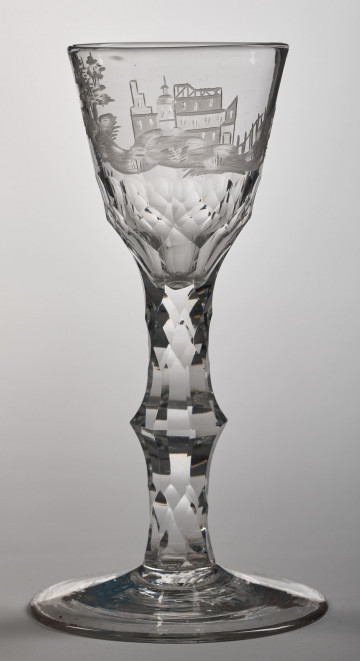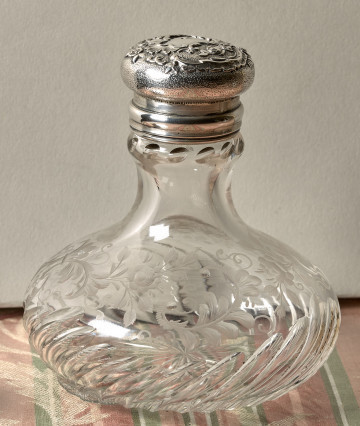
Glass with a castle motif
18th century
Castle Museum in Łańcut
Part of the collection: Goldsmiths
Mirror from the museum collection, of mirror glass and silver; made in Vienna, towards the end of the 19th/ beginning of the 20th centuries. The mirror has an oval shape, is small, double-sided, in a silver, profiled frame (housing), decorated with a pearl ornament band. Along the lengthwise axis of the mirror, there is a holder (handle), widening at the top and bottom, with the central part narrower; it is made of two parts fixed together by threaded nuts. Mirrors rank among the oldest human inventions, and researchers indicate that ground surfaces of stones and rocks were used as mirrors in paleolithic times. In Antiquity mirrors became popular that were made of polished metals, such as bronze, lead, silver. In Antiquity, such mirrors were used not only to view one’s reflection, but properly placed (in the right numbers and at the right angles) allowed one to light darker spaces in sacred and private architecture. In the first century, Romans mastered the art of making mirrors of glass, however, they seem not to have gained popularity and became forgotten for centuries. Mirrors of ground and polished metal thrived in Europe until the end of the middle ages. Glass mirrors emerged in Europe again thanks to Muslims from Spain. From the end of the middle ages, glass mirrors became ever more popular, to quickly take over where metal ones dominated. Still, metal continued to be used in new glass mirrors as the rear side of the mirror, mainly lead, silver or mercury. Presently, with improved awareness and care for the environment, mirrors started to be produced that use vacuum-coated aluminium glass.
Dimensions
height: 25.3 cm, width: 11.6 cm
Object type
Goldsmithing
Technique
mill forming
Material
glass, silver
Creation time / dating
Owner
Castle Museum in Łańcut
Identification number
Location / status

18th century
Castle Museum in Łańcut

1920
Castle Museum in Łańcut

1920
Castle Museum in Łańcut
DISCOVER this TOPIC
National Museum in Lublin
DISCOVER this PATH
Educational path